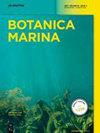沙质影响对潮间带岩石海岸上纹状Mazzaella laminarioides (rhodophya, Gigartinales)形态的影响
IF 1.4
4区 生物学
Q2 MARINE & FRESHWATER BIOLOGY
引用次数: 0
摘要
摘要形态变异在大型藻类中很常见。在智利中部,Mazzaella laminarioides延伸到整个潮间带岩石带,据报道,那里的叶片长到20 厘米长。然而,在受沙影响的低岩潮间带,叶片明显大于没有沙影响的其他海岸。本研究的目的是比较两种不同条件下扁桃叶片的形态。用传统的形态测量法对四个有和四个没有沙尘影响的地点采集的叶片进行了评估。结果表明,受沙尘影响的场地叶片更长、更宽。砂蚀没有直接评价,但间接影响,如裸岩和耐砂物种的丰度在受砂影响的地区较高。此外,长叶片仅限于受沙子影响的地点,支持这两个变量之间的关系。利用COI标记进行分子分析,证实大叶片个体为laminarioides。结果表明,叶片大小与生命周期阶段、季节性和垂直高度无关。我们认为,大叶片限制在受沙影响的地点可能与基底固结物在遭受沙磨损后的愈合过程有关。本文章由计算机程序翻译,如有差异,请以英文原文为准。
Effect of sand-influence on the morphology of Mazzaella laminarioides (Rhodophyta, Gigartinales) on rocky intertidal shores
Abstract Morphological variability is common among macroalgae. In central Chile, Mazzaella laminarioides extends throughout the intertidal rocky zones, where blades are reported to grow up to 20 cm in length. Nevertheless, in low rocky intertidal zones with sand-influence, blades are noticeably larger than in other shores without sand effect. The aim of this study was to compare the morphology of M. laminarioides blades from two different conditions. Blades collected from four sites with, and four without, sand-influence were evaluated with traditional morphometry. Results showed that blades were longer and wider in sand-influenced sites. Sand abrasion was not directly evaluated, but indirect effects such as the abundance of bare rock and of sand tolerant species were higher in areas with sand-influence. Also, long blades were restricted to sand-influenced sites, supporting the relation between these two variables. Molecular analyses using the COI marker confirmed large-bladed individuals as M. laminarioides. Results indicated that life cycle phase, seasonality and vertical height were not related to large blades. We suggest that restriction of large blades to sand-influenced sites may be related to the healing processes of basal holdfasts after suffering sand abrasion.
求助全文
通过发布文献求助,成功后即可免费获取论文全文。
去求助
来源期刊

Botanica Marina
生物-海洋与淡水生物学
CiteScore
4.10
自引率
4.50%
发文量
43
期刊介绍:
Botanica Marina publishes high-quality contributions from all of the disciplines of marine botany at all levels of biological organisation from subcellular to ecosystem: chemistry and applications, genomics, physiology and ecology, phylogeny and biogeography. Research involving global or interdisciplinary interest is especially welcome. Applied science papers are appreciated, particularly when they illustrate the application of emerging conceptual issues or promote developing technologies. The journal invites state-of-the art reviews dealing with recent developments in marine botany.
 求助内容:
求助内容: 应助结果提醒方式:
应助结果提醒方式:


